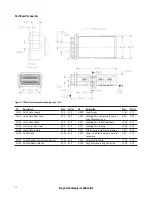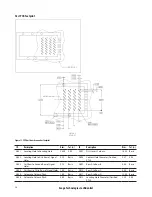
14
Avago Technologies Confidential
Control Interface
The control interface includes a bi-directional Int_L/
Reset_L interrupt/reset signal and two-wire serial – SCL
(clock) and SDA (data) signals to provide users rich func-
tionality over an efficient and easily used interface. The
TWS interface is implemented as a slave device and com-
patible with industry standard two-wire serial protocol.
Signal and timing characteristics are further defined in
this section. In general, TWS bus timing and protocols
follow the implementation popularized in Atmel Two-wire
Serial EEPROMs.
Low-Speed Electrical Contact Definitions
SDA, SCL
SCL is the clock of the two-wire serial interface, and SDA is
the data for the two-wire interface. SCL and SDA must be
pulled up in the host through a pull-up resistor of value
appropriate to the overall bus capacitance and the rise
and fall time requirements as per “CXP two-wire Serial
Interface Timing Specifications” table.
The host supplied SCL input to the CXP transceiver is used
to positive-edge clock data into each CXP device and neg-
ative-edge clock data out of each device. CXP transceivers
operate only as slave devices. The host must provide a bus
master for SCL and initiate all read/write communication.
Since all CXP transceivers use the same two base
addresses, each CXP port requires its own SCL/SDA bus.
Support of multiple ports in a host requires multiple SCL/
SDA buses, or multiplexing circuitry such as a multiplexer
chip or a switch chip.
INT_L/RESET_L
Int_L/Reset_L is a bidirectional contact. When driven
from the host, it op erates logically as a Reset signal.
When driven from the module, it oper ates logically as an
Interrupt signal. In both cases, the signal is asserted low,
as indicated by the ’_L’ suffix. The Int_L/Reset_L signal
requires open collector outputs in both the host and
the module, and must be pulled up on the host board
with 1.5 kohm – 10 kohm resistor. The two uses are
distinguished by timing – a shorter assertion, driven by
the module indicates an interrupt and a longer assertion
of the signal driven by the host indicates a reset as per “I/O
Timing for Control and Status Functions” Table below.
Int_L operation:
When Int_L/Reset_L is pulled “Low” by the module for
longer than the minimum pulse width (t
Int_L, PW-min
) and
shorter than the maximum pulse width (t
Int_L, PW-max
) the
signal signifies an interrupt. When asserted “Low”, Int_L
indicates a possible module operational fault or a status
critical to the host system. The host identifies the cause
of the interrupt using the two-wire serial interface. Int_L
must operate in Pulse mode (as opposed to Static mode),
in order to distinguish a short Int_L signal from a longer
Reset_L signal, so the module must de-assert Int_L/
Reset_L after the interrupt has been signaled.
Reset_L operation:
When the Int_L/Reset_L signal is pulled “Low” by the
host for longer than the minimum reset pulse length
(
t
Reset_L,PW-min
), it ini tiates a complete module reset,
returning all user module settings to their default state.
There is no maximum reset pulse length. Module Reset
Assert Time (t_init) starts on the rising edge after the
low level on the Reset_L signal is released. During the
execution of a reset (t_init) the host shall disregard all
status bits until the module indicates a completion of the
reset interrupt. The module indicates this by posting an
Int_L signal with the Data_Not_Ready bit (Memory Map,
Byte 2, bit 0) negated. Note that on power up (including
hot insertion) the module will post this completion of
reset interrupt without requiring a reset from the host.
PRSNT_L
PRSNT_L is used to indicate when the module it plugged
into the host re ceptacle. PRSNT_L is pulled up to Vcc3.3
on the host board through > 50 k
W
and pulled down
directly to signal common (no re sistor) in the module. The
PRSNT_L is asserted “Low” when inserted and deas serted
“High” when the module is physically absent from the host
con nector.


























